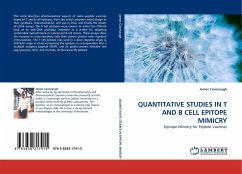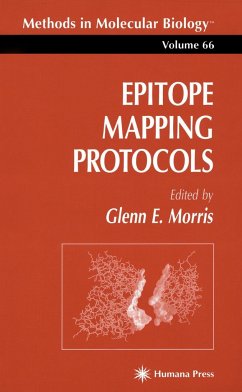
QUANTITATIVE STUDIES IN T AND B CELL EPITOPE MIMICRY
Epitope Mimicry for Peptide Vaccines
Versandkostenfrei!
Versandfertig in 6-10 Tagen
39,99 €
inkl. MwSt.

PAYBACK Punkte
20 °P sammeln!
This work describes pharmaceutical aspects of some peptide vaccines based on T and B cell epitopes, from the initial computer-aided design to their synthesis, characterization, and use in mice, and finally the results of ELISA assays. The B cell epitopes were chosen to mimic the CDR-H3 loop of an anti-DNA antibody, intended as a model for targeting undesirable (autoimmune or cancerous) B cell clones. These assays show the increase in cross-reactivity with their parent protein with repeated immunization. The T cell epitope was used in a dose response study (a 300-fold range in dose) comparing t...
This work describes pharmaceutical aspects of some peptide vaccines based on T and B cell epitopes, from the initial computer-aided design to their synthesis, characterization, and use in mice, and finally the results of ELISA assays. The B cell epitopes were chosen to mimic the CDR-H3 loop of an anti-DNA antibody, intended as a model for targeting undesirable (autoimmune or cancerous) B cell clones. These assays show the increase in cross-reactivity with their parent protein with repeated immunization. The T cell epitope was used in a dose response study (a 300-fold range in dose) comparing the epitope, its incorporation into a multiple antigenic peptide (MAP), and its parent protein (chicken hen egg lysozyme, HEL), and controls, all fluorescently labeled.












